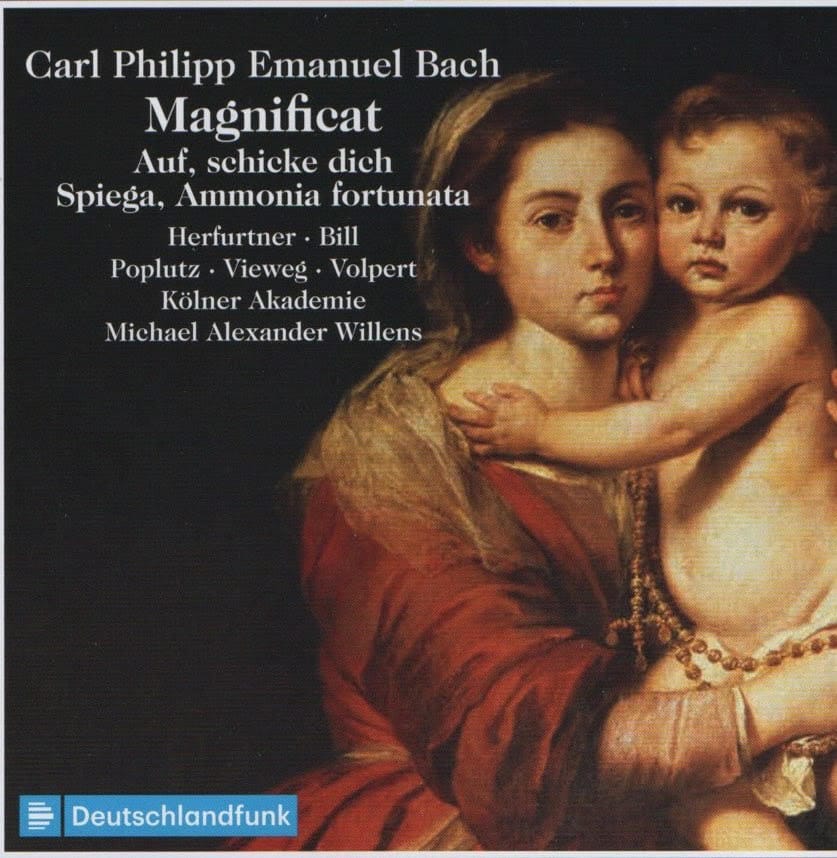Magnificat! C. P. E. Bach's - plus a Christmas Cantata
A fabulous disc of rococo gems courtesy of C. P. E. Bach, and perfect for the season!

The excellent cpo label carries us towards Christmas and continues our celebration of Yule with works by C. P. E. Bach (1714-1788). It features Michael Alexander Willems and his Kölner Akademie, a combination we have met before in Christmas Cantatas by Ernst Wilhelm Wolf, Passion Oratorios by Johann David Heinichen, not to mention Telemann's wonderful Johannes-Oratorium (all cpo) and Weber's works for keyboard and orchestra (BIS).
The Magnificat (Wq 215: No. 215 in the Wotquenne catalogue*) dates from C.P.E.'s Berlin period. There are two versions (1.1 and 1.2, officially). It was probably performed in March 1750 at St Thomas', Leipzig, conducted by the composer - it was certainly completed on August 25, 1749, and there is a later version from the last decade of his life, when it was performed in revised form in 1779. The earlier version contains two horns but no trumpets, and the later includes three trumpet parts, so this is the later version.
Like his dad's Christmas Oratorio, C. P. E. 's Magnificat begins with a blaze of glory (“Magnificat anima mea Dominum”), trumpets backing exultant string scales, no hint of contrasts to come (they return in the “Fecit potentiam,” with a very different function):
The first aria, ”Quia respexit” is given to soprano, here the excellent Hanna Herfurtner:
“Quia fecit” (For he that is mighty) is a tenor aria, and I like Georg Poplitz's beautiful tone - he almost has a baritone tinge:
But how powerful is that “Et misericordia” chorus:
After all the spotlight for the trumpets, nice to hear the horns foregrounded in the duet, “Deposuit potentes de sede” (He hath put down the mighty from their seat). This is soprano Hanna Herfortner and tenor Georg Pollitz in heavenly accord, and a word for the popping accuracy of horn players Gerard Serrano Garcia and Pepe Reche:
Alto Elvira Zill's “Seuscepit Israel puerum suum” (He remembering his servant hath helped his servant Israel) is beautifully expressive:
The brightness of the opening recurs in the “Gloria patri” (Glory to the father), a trumpet announcing the “Amen”s before counterpoint rules the day for the final “Sicut erat in principio”:
A brief chorus follows on the disc, another “Et misricordia”. This is dated 1749, Berlin but appears without catalogue number of any sort; it is the original version of the chorus that is heard within the second version above. This version allows in shade in passages for the soloists:
A chorale announces the Christmas Cantata Auf, schicle dich (Arise, make haste) before baritone Markus Volpert gives a fine, strong account of “Groß its Der Herr” (Great is the Lord), with some lovely obbligato oboe playing (Christopher Palameta and Mathieu Loux) before a positively thunderous timpani roll heralds drama one might find in Telemann (say, the Donnerode) than J. S. B.:
The tenor and chorus aria, “Groß ist der Herr” (Great is the Lord”) is particularly inspired, not only in the tenor component and its melody, but also the way C. P. E. moves to the chorus - and the serene nature of the chorus itself berfore it opens our into a chorus of praise. All in less than three minutes!:
Most beautiful, though, is the duet for soprano and alto (Herfuurtner and Bill) and two obbligato flutes (Sophia Arenz and Mariya Millulsina), “Also hat Gott die ganze Welt geliebet” (For God so loved the world).
Even the final, 45-second chorus makes its mark here. What a beautiful piece this is!
The disc closes with a chorus, Spiega, Ammonia fortunate, W 216 (H 829): "Ammonia” is the Italian for Hamburg! Full forces here, including three trumpets and two horns. The piece was written for the visit of the Swedish crown prince to Hamburg in 1770, apparently composed in twelve hours. The crown prince was later King Gustav III of Sweden, he who was assassinated in 1792 at a masked ball (which event inspired the Verdi opera Un ballo in marchera, the earlier version of which was called Gustavo III).
A fabulous disc of rococo gems courtesy of C. P. E. Bach, and perfect for the season!
- *as a reminder, as we have mentioned this before in previous posts, Wq numbers refer to a catalogue of C. .P. E. Bach's works by Alfred Wotquenne (1867-1939). These are the “Wq” numbers. There is another catalogue that is also used, that by E. Eugene Helm (H numbers). If you navigate to this site, you'll find a C. P. E. Bach search engine (!) that allows you to search Wq and H numbers, or a search term from title to find the equivalencies between Wq and H numbers. We need more of these!

